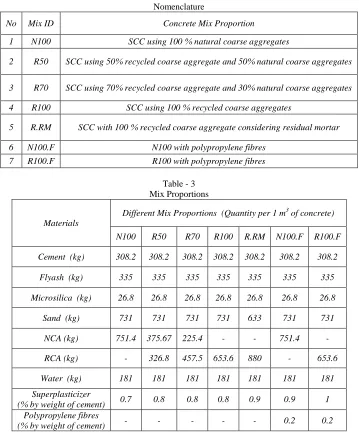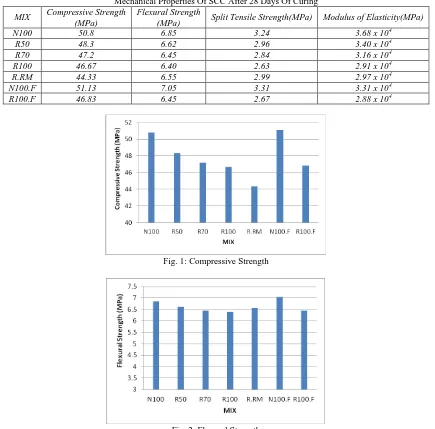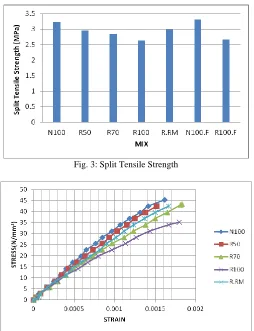A Study on the Self Compacting Properties of
Recycled Concrete Incorporating a New Mix
Proportioning Method
Ajith V Praveen Mathew
PG Student Assistant Professor
Department of Civil Engineering Department of Civil Engineering Mar Athanasius College of Engineering, Kothamangalam,
Kerala.
Mar Athanasius College of Engineering, Kothamangalam, Kerala.
Abstract
This paper justifies and encourages the use of recycled coarse aggregate (RCA) as a replacement to normal coarse aggregate (NCA) in the production of self compacting concrete (SCC). The properties of RCA is mainly governed by the presence of residual mortar (RM) content, which is a mixture of cement, sand and water that adheres firmly to the aggregate surface. The physical and mechanical properties of all the materials were carried out. In this study, the mix design is achieved by incorporating most of Indian Standard specifications and mix proportions were arrived through a number of trial mixes by changing and balancing the powder content and water-powder ratio. The NCA has been replaced with RCA at varying amounts of 0%, 50%, 70% and 100%. The properties of all these mixes in fresh state as well as in hardened state are studied. The effects of polypropylene fibres are also studied. The experimental results indicate that the fresh state properties of SCC can be effectively achieved using RCA. In the hardened state, strength of SCC decreases with an increase in recycled aggregate replacement ratios. But the loss of strength seems to be only marginal which highly encourages the use of RCA in the construction industry as a sustainable solution to environmental protection.
Keywords: Self Compacting Concrete(SCC), Recycled Coarse Aggregate(RCA), Fresh Properties, Hardened Properties ________________________________________________________________________________________________________
I.
INTRODUCTION
Science and technology advances at a rapid rate and has revolutionalised every fields of day to day life. Construction industry also has equipped with many new technologies that replaces the outdated traditional methods. One of such innovation led to the formation of self compacting concrete (SCC) which does not require any manual or mechanical vibrators for its compaction [1]. It flows under its own weight filling all the voids and spaces and achieving full compaction even in the presence of highly congested reinforcements. In recent years, the use of SCC has gained a wider acceptance.
As a nation develops at a rapid rate, its transportation systems, communication facilities etc, need to be widened within the available space. The lack of space for new development demands the demolition of old and aged buildings [2]. These construction and demolition waste used as a landfill is no longer a feasible solution. The concept of sustainable development that achieved world wide acceptance necessitates the recycling and reuse of construction waste.
In order to attain the self compacting properties, many chemical and mineral admixtures are used which makes SCC costlier than conventional concrete. In this study we are trying to minimise the cost of production with the help of maximum use of industrial waste materials like RCA, fly ash etc [3]. Fly ash is the byproduct obtained by electrostatic and mechanical means from the flue gases of power station furnaces fired with pulverised coal which could be obtained free of cost. This study justifies and encourages the use of RCA in the economical production of SCC without compromising its strength characteristics.
Fibres are generally used to enhance various properties of concrete [4]. This study discusses a brief analysis on the effect of polypropylene fibres on the fresh and hardened properties of SCC using NCA and RCA [5].
II.
LITERATURE SURVEY
L.A. Pereira-de-Oliveira et al. [7] studied permeability properties of self compacting concrete with coarse recycled aggregates. Regarding the compressive strength, it was observed only 3.3% of strength loss with the maximum recycled aggregate incorporation. Finally, the possibility to increase the use of recycled aggregates volume in self-compacting concrete may be regarded as a great environmental and economical benefit.
K C Panda et al. [8] studied the effect of recycled coarse aggregate on SCC properties. NCA is partially replaced with RCA by an amount 10%, 20%, 30% and 40%. The effect of RCA on the properties of SCC in green state and properties of concrete in hardened state are studied. The mix design was carried out for M25 grade of concrete. The experimental results indicate that the compressive strength, flexural strength and split tensile strength of the SCC with 100% natural aggregate is less than the normal vibrated concrete (NVC) with 100% natural aggregate and the strength of SCC decreases with an increase in recycled aggregate (RA) replacement ratios. RCA show higher water absorption compared with conventional NCA due to old mortar attached with original concrete and has relatively lower specific gravity.
Okamura et al. [9] carried out experiments to study the flowability of self-compacting concrete. A model frame work was used to observe how SCC could pass through obstacles. Okamura proposed a simple system of mix proportioning procedure for SCC. Accordingly, the coarse aggregate content was fixed as 50% of the solid volume; the fine aggregate content as 40% of mortar volume and w/c ratio in volume as 0.9 to 1.1.
Ozawa et al. [10] completed the first prototype of self-compacting concrete using materials already on the market. By using different types of super plasticizer, he studied the workability of concrete and developed a concrete which was very workable. It was suitable for rapid placement and had a very good permeability. The viscosity of the concrete was measured using the v-funnel test. Other experiment carried out by Ozawa focussed on the influence of mineral admixtures like fly ash and blast furnace slag, on the flowing ability and segregation resistance of SCC.
III.
EXPERIMENTAL STUDY
Materials Used: A.
The different materials used in this study were Binder materials, Fine aggregate, NCA, RCA, superplasicizer, polypropylene fibres and water. The binder materials include cement, fly ash and microsilica. Ordinary Portland cement of grade 53 is used here. Fly ash used was ASTM Class F fly ash with specific gravity 2.14. M sand was used as fine aggregate. It conforms to IS 383:1970 Zone II. Both natural and recycled coarse aggregates of maximum size 12.5 mm were used for this study. MasterGlenium SKY 8233 from BASF chemical company was used as superplasticizer for the study. All the material properties were determined and the properties of different aggregates were tabulated in Table 1.
Table - 1
Properties Of Different Aggregates Used
Aggregates Specific gravity Impact value (%) Crushing value (%) Abrasion value (%) Water absorption (%)
M-sand 2.68 - - - 13.89
NCA 2.69 29.16 33.29 43.01 0.6
RCA 2.34 30.28 35.16 45.32 5
Mix Proportioning: B.
There is no standard or all-encapsulating method for determining mixture proportions, currently exists for SCC. However, many academic institutions, ready-mixed, precast and contracting companies have developed their own mix proportioning methods. In this study a mix design, incorporating most of Indian Standards specifications has been tried.
In order to obtain self compacting properties, the powder content of the mix should be very high. Mix proportions were arrived through trial mixes. Initially a suitable powder content as well as water-powder ratio was selected. 50% of the total powder content has been replaced by fly ash and 4% by microsilica. From water-powder ratio, the quantity of water required for the mix could be calculated. The proportion of volume of coarse and fine aggregates has been determined as per IS 10262-2009[11]. By deducting the volume of known ingredients the volume of all in aggregates could be obtained. Specific gravity being determined, quantity of all the materials required for 1m3 of concrete is calculated.
Different mixes were prepared with 0%, 50%, 70% and 100% replacement of NCA with RCA. A mix was also designed considering the residual mortar content of RCA. The residual mortar content in RCA was experimentally found to be 25 %. Therefore the required amount of coarse aggregates according to mix proportion will not be there since 25 % of it will be the mortar formed from the combination of cement, sand and water. Hence for this mix reduction was made for the sand content and corresponding addition was made for weight of coarse aggregates. Mix proportion with identification based on replacement ratio is given in Table II.
conducted. Trial mix that satisfies the slump value and V-funnel value was selected as the suitable mix. The powder content was finally fixed to be 670 kg per cubic meter of concrete and a water/powder ratio of 0.27 was adopted. The mix proportions of different mixes are given in Table III.
Table - 2 Nomenclature
No Mix ID Concrete Mix Proportion
1 N100 SCC using 100 % natural coarse aggregates
2 R50 SCC using 50% recycled coarse aggregate and 50% natural coarse aggregates
3 R70 SCC using 70% recycled coarse aggregate and 30% natural coarse aggregates
4 R100 SCC using 100 % recycled coarse aggregates
5 R.RM SCC with 100 % recycled coarse aggregate considering residual mortar
6 N100.F N100 with polypropylene fibres
7 R100.F R100 with polypropylene fibres
Table - 3 Mix Proportions
Materials
Different Mix Proportions (Quantity per 1 m3 of concrete)
N100 R50 R70 R100 R.RM N100.F R100.F
Cement (kg) 308.2 308.2 308.2 308.2 308.2 308.2 308.2
Flyash (kg) 335 335 335 335 335 335 335
Microsilica (kg) 26.8 26.8 26.8 26.8 26.8 26.8 26.8
Sand (kg) 731 731 731 731 633 731 731
NCA (kg) 751.4 375.67 225.4 - - 751.4 -
RCA (kg) - 326.8 457.5 653.6 880 - 653.6
Water (kg) 181 181 181 181 181 181 181
Superplasticizer
(% by weight of cement) 0.7 0.8 0.8 0.8 0.9 0.9 1 Polypropylene fibres
(% by weight of cement) - - - - - 0.2 0.2
Result and Discussion: C.
The fresh and hardened properties of concrete were determined and studied for all the mixes. In the fresh state slump flow, T-500, V-funnel and L-box tests were conducted. The obtained value satisfies the EFNRC [1] guidelines and is tabulated below in Table IV.
Table - 4 Fresh Properties Of SCC
Mix Slump Flow (mm)
T500
(s)
V Funnel Time (s)
L-Box (PA)
N100 710 4 20 0.91
R50 690 4 21 0.88
R70 670 5 22 0.85
R.RM 630 6 23 0.83
N100.F 685 5 22 0.85
R100.F 660 6 21 0.87
The slump flow measures the average diameter of flow using a slump cone. T-500 measures the time required for the mix to flow 500 mm diameter in the slump flow test. Both these test measures flowability and cohesiveness of the mix respectively. The time required for the mix to flow out of V-Funnel is recorded and it act as a measure of segregation resistance of the mix. The ratio of different heights in both the legs of the L-Box equipment gives passing ability(PA) of the mix.
The results show that all the mixes satisfy the requirements of SCC. However, these results show a wide range of variation. This variation illustrates the effect of recycled coarse aggregate variation and addition of polypropylene fibres on different fresh properties of SCC mixes. As the percentage of recycled coarse aggregate increases, the flowability of the mix decreases. The reduction in flow of concrete may be due to the presence of angular materials in manually broken recycled coarse aggregate. The NCA in SCC was more rounded in shape than RCA, so fresh properties are better for SCC without any recycled aggregates. The hardened concrete properties such as compressive strength, flexural strength, split tensile strength and modulus of elasticity were tested in the laboratory after 28 days of curing. 150mm x 150mm x 150mm moulds were used to cast cubes to determine the compressive strength of the concrete. 150mm x 300mm moulds were used to cast cylinders to determine split tensile strength and modulus of elasticity of the concrete. 100mm x 100mm x 500mm moulds were used to cast beams to determine the flexural strength of concrete. The test results have been tabulated in Table V.
Table - 5
Mechanical Properties Of SCC After 28 Days Of Curing
MIX Compressive Strength (MPa)
Flexural Strength
(MPa) Split Tensile Strength(MPa) Modulus of Elasticity(MPa)
N100 50.8 6.85 3.24 3.68 x 104
R50 48.3 6.62 2.96 3.40 x 104
R70 47.2 6.45 2.84 3.16 x 104
R100 46.67 6.40 2.63 2.91 x 104
R.RM 44.33 6.55 2.99 2.97 x 104
N100.F 51.13 7.05 3.31 3.31 x 104
R100.F 46.83 6.45 2.67 2.88 x 104
Fig. 1: Compressive Strength
Fig. 3: Split Tensile Strength
Fig. 4: Stress Strain Curve for Different Mixes
The graphical representation of variation of compressive strength, flexural strength, split tensile strength and stress-strain curve of different mixes are shown in Fig.1, Fig.2, Fig.3 and Fig.4 respectively. Among all the mixes, NCA100 gives the highe st strength followed by RCA50, RCA70 and RCA100. RCA.RM gives more flexural and split tensile strength than RCA100. In all the cases the loss of strength due to addition of RCA seems to be only marginal. Hence it is of high structural use as a replacement to NCA. The addition of polypropylene fibres does not show much influence on the strength characteristics.
IV.
CONCLUSIONS
The fresh properties of self compacting concrete were found to be satisfactory for all the mixes. Workability of recycled coarse aggregate was found to be less when compared with normal coarse aggregate, but it satisfies all the fresh state properties easily. The result highly justifies the use of recycled coarse aggregates as a replacement to normal coarse aggregates in the production of SCC.
The compressive strength of RCA100 is about 92 % of SCC made with mix NCA100. Since the loss of strength is very less, the recycled coarse aggregates can be effectively used as a replacement to normal coarse aggregates. Flexural strength of RCA100 was found to be 93 % of that with mix NCA100. Since the maximum reduction is just around 7% it is an encouraging sign to promote the use of RCA in structural concrete. Split tensile strength for RCA100 was found to be 81 % of that with mix NCA100. Elastic Modulus of RCA is found to be lower than NCA.
It was found that no considerable change in the hardened properties of SCC was found by the addition of polypropylene fibres, though the compressive strength, flexural strength and split tensile strength were slightly increased. The experimental results highly recommend and encourage the use of RCA as a replacement for NCA in structural concrete.
REFERENCES
[1] EFNARC (2002) Specification and Guidelines for Self Compacting Concrete, EFNARC UK
[2] R. V. Silva, J. de Brito, R. K. Dhir, “Properties and composition of recycled aggregates from construction and demolition waste suitable for concrete production” , Construction and Building Materials 65, 2014, pp 201–217
[3] Dhiyaneshwaran S, Ramanathan P, Bhaskar I, Venkatasubramani R, “Study on durability characteristics of self compacting concrete with fly ash”, Jordan Journal of Civil Engineering, Volume 7, No. 3, 2013
[5] Junaid Ahmad, Raj Bandhu Dixit, Rahul Singh, “To study the properties of self compacting concrete using recycled aggregate and polypropylene fibre”, IJRRCME, Vol.2, Issue 1, pp 173-177
[6] Zoran Jure Grdic, Gordana A. Toplicic-Curcic, Iva M Despotovic, Nenad S. Ristic, “Properties of self compacting concrete prepared with coarse recycled concrete aggregrate” Construction and Building Materials 24, 2010, pp.1129-1133
[7] L.A. Pereira-de-Oliveira, M.C.S. Nepomuceno, J.P. Castro-Gomes, M.F.C. Vila , “Permeability properties of self compacting concrete with coarse recycled aggregates”, Construction and Building Materials 51, 2014, pp.113-120
[8] K C Panda, P K Bal, “Properties of Self Compacting Concrete using recycled coarse aggregate” Procedia Engineering, 2013, pp.159-164 [9] Okamura H. et al., “Self Compacting Concrete”, Journal of advanced concrete technology, 2003, Vol. 1, No 1, Japan concrete institute [10] Ozawa K., “Development of high performance concrete based on the durability design of concrete structures”, 1989, pp. 445-450
[11] Dr. Elson John, Deepthy Varkey, Sija K Sam, “Self Compacting Concrete with Recycled Coarse Aggregates”, IJERT September 2014, Vol 3, Issue 9, ISSN: 2278-0181
[12] Prashant O. Modani, Vinod M. Mohitkar,“Recycled Aggregate Self Compacting Concrete: A Sustainable Concrete for Structural use”, IJERT January 2015, Vol 4, Issue 1, ISSN: 2278-0181
[13] Shetty M. S., Concrete Technology Theory and Practice, S. Chand & Company Ltd., New Delhi, 2005


